Health Informatics Project: EHR System Implementation Assessment
VerifiedAdded on 2022/10/10
|11
|2940
|19
Project
AI Summary
This project focuses on the implementation of an Electronic Health Record (EHR) system at Nicklaus Children's Hospital. It begins with an introduction to healthcare information technology and the benefits of EHRs, including reduced medication errors and improved patient care. The project outlines the organization details of Nicklaus Children's Hospital and envisions the future with an improved EHR system, emphasizing the need for modifications to address current limitations and ethical aspects. SMART goals are established to guide the implementation process, focusing on specific, measurable, achievable, relevant, and timely objectives. The project details the implementation plan, including clarifying and prioritizing the process, chart abstraction, and steps in meaningful use. It addresses challenges such as employee resistance and proposes solutions like training sessions. The project aims to improve data management, reduce errors, and enhance the speed of the work process. Continuous evaluation and monitoring are planned to ensure meaningful use and positive patient outcomes. The project concludes by summarizing the current problems and the anticipated positive outcomes of the EHR implementation.

Running head: HEALTH INFORMATICS
Paraphrase This Document
Need a fresh take? Get an instant paraphrase of this document with our AI Paraphraser
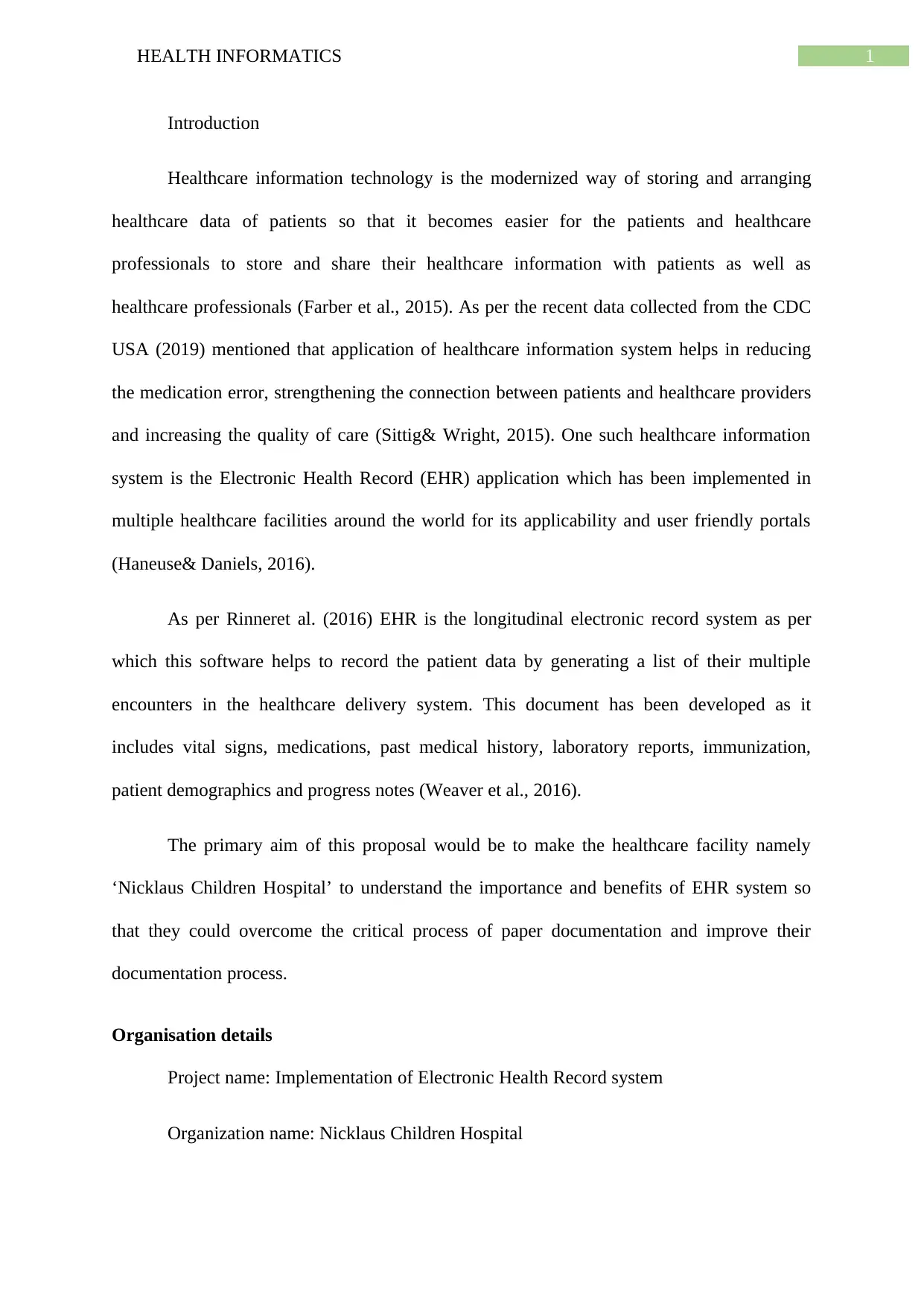
1HEALTH INFORMATICS
Introduction
Healthcare information technology is the modernized way of storing and arranging
healthcare data of patients so that it becomes easier for the patients and healthcare
professionals to store and share their healthcare information with patients as well as
healthcare professionals (Farber et al., 2015). As per the recent data collected from the CDC
USA (2019) mentioned that application of healthcare information system helps in reducing
the medication error, strengthening the connection between patients and healthcare providers
and increasing the quality of care (Sittig& Wright, 2015). One such healthcare information
system is the Electronic Health Record (EHR) application which has been implemented in
multiple healthcare facilities around the world for its applicability and user friendly portals
(Haneuse& Daniels, 2016).
As per Rinneret al. (2016) EHR is the longitudinal electronic record system as per
which this software helps to record the patient data by generating a list of their multiple
encounters in the healthcare delivery system. This document has been developed as it
includes vital signs, medications, past medical history, laboratory reports, immunization,
patient demographics and progress notes (Weaver et al., 2016).
The primary aim of this proposal would be to make the healthcare facility namely
‘Nicklaus Children Hospital’ to understand the importance and benefits of EHR system so
that they could overcome the critical process of paper documentation and improve their
documentation process.
Organisation details
Project name: Implementation of Electronic Health Record system
Organization name: Nicklaus Children Hospital
Introduction
Healthcare information technology is the modernized way of storing and arranging
healthcare data of patients so that it becomes easier for the patients and healthcare
professionals to store and share their healthcare information with patients as well as
healthcare professionals (Farber et al., 2015). As per the recent data collected from the CDC
USA (2019) mentioned that application of healthcare information system helps in reducing
the medication error, strengthening the connection between patients and healthcare providers
and increasing the quality of care (Sittig& Wright, 2015). One such healthcare information
system is the Electronic Health Record (EHR) application which has been implemented in
multiple healthcare facilities around the world for its applicability and user friendly portals
(Haneuse& Daniels, 2016).
As per Rinneret al. (2016) EHR is the longitudinal electronic record system as per
which this software helps to record the patient data by generating a list of their multiple
encounters in the healthcare delivery system. This document has been developed as it
includes vital signs, medications, past medical history, laboratory reports, immunization,
patient demographics and progress notes (Weaver et al., 2016).
The primary aim of this proposal would be to make the healthcare facility namely
‘Nicklaus Children Hospital’ to understand the importance and benefits of EHR system so
that they could overcome the critical process of paper documentation and improve their
documentation process.
Organisation details
Project name: Implementation of Electronic Health Record system
Organization name: Nicklaus Children Hospital
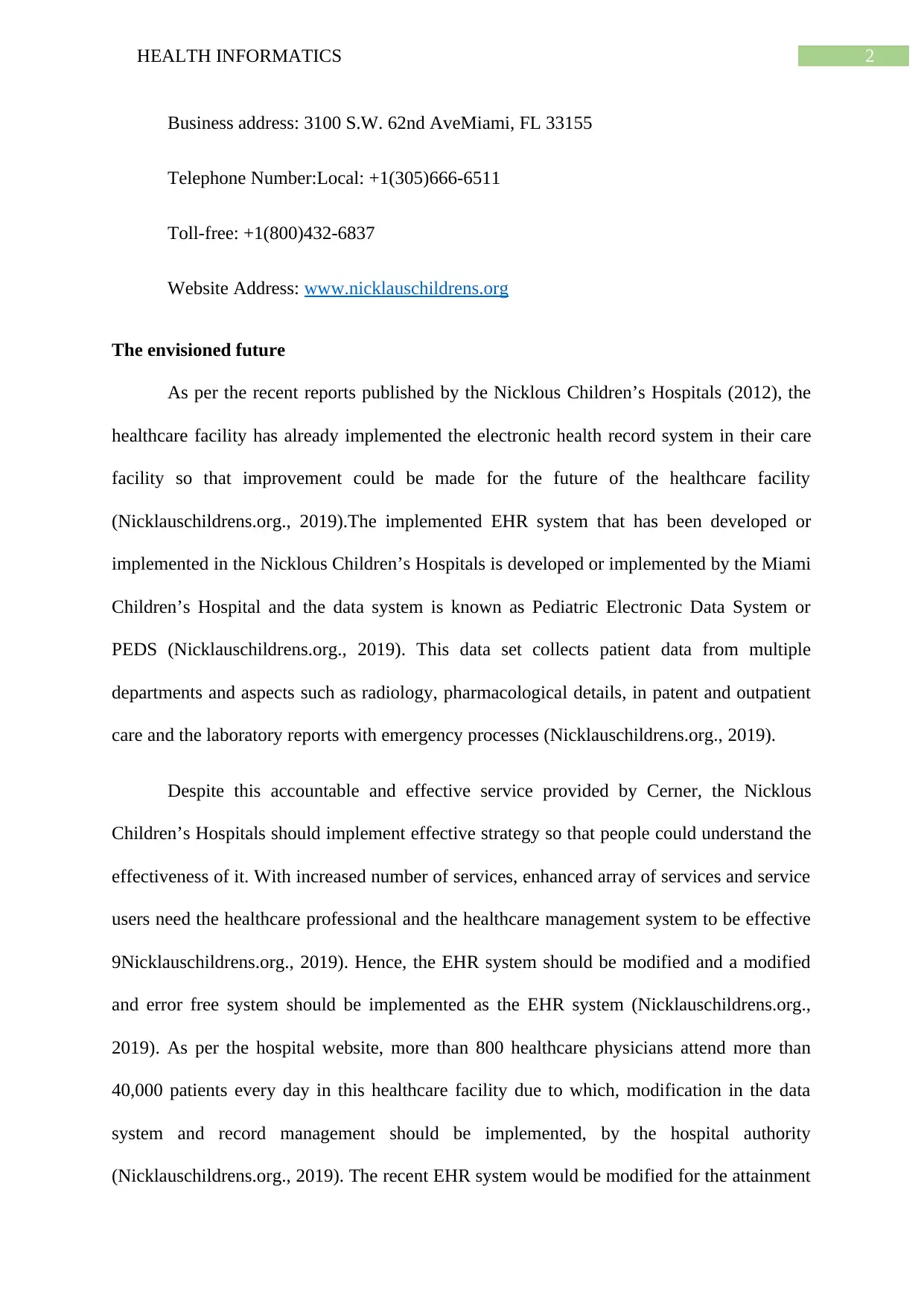
2HEALTH INFORMATICS
Business address: 3100 S.W. 62nd AveMiami, FL 33155
Telephone Number:Local: +1(305)666-6511
Toll-free: +1(800)432-6837
Website Address: www.nicklauschildrens.org
The envisioned future
As per the recent reports published by the Nicklous Children’s Hospitals (2012), the
healthcare facility has already implemented the electronic health record system in their care
facility so that improvement could be made for the future of the healthcare facility
(Nicklauschildrens.org., 2019).The implemented EHR system that has been developed or
implemented in the Nicklous Children’s Hospitals is developed or implemented by the Miami
Children’s Hospital and the data system is known as Pediatric Electronic Data System or
PEDS (Nicklauschildrens.org., 2019). This data set collects patient data from multiple
departments and aspects such as radiology, pharmacological details, in patent and outpatient
care and the laboratory reports with emergency processes (Nicklauschildrens.org., 2019).
Despite this accountable and effective service provided by Cerner, the Nicklous
Children’s Hospitals should implement effective strategy so that people could understand the
effectiveness of it. With increased number of services, enhanced array of services and service
users need the healthcare professional and the healthcare management system to be effective
9Nicklauschildrens.org., 2019). Hence, the EHR system should be modified and a modified
and error free system should be implemented as the EHR system (Nicklauschildrens.org.,
2019). As per the hospital website, more than 800 healthcare physicians attend more than
40,000 patients every day in this healthcare facility due to which, modification in the data
system and record management should be implemented, by the hospital authority
(Nicklauschildrens.org., 2019). The recent EHR system would be modified for the attainment
Business address: 3100 S.W. 62nd AveMiami, FL 33155
Telephone Number:Local: +1(305)666-6511
Toll-free: +1(800)432-6837
Website Address: www.nicklauschildrens.org
The envisioned future
As per the recent reports published by the Nicklous Children’s Hospitals (2012), the
healthcare facility has already implemented the electronic health record system in their care
facility so that improvement could be made for the future of the healthcare facility
(Nicklauschildrens.org., 2019).The implemented EHR system that has been developed or
implemented in the Nicklous Children’s Hospitals is developed or implemented by the Miami
Children’s Hospital and the data system is known as Pediatric Electronic Data System or
PEDS (Nicklauschildrens.org., 2019). This data set collects patient data from multiple
departments and aspects such as radiology, pharmacological details, in patent and outpatient
care and the laboratory reports with emergency processes (Nicklauschildrens.org., 2019).
Despite this accountable and effective service provided by Cerner, the Nicklous
Children’s Hospitals should implement effective strategy so that people could understand the
effectiveness of it. With increased number of services, enhanced array of services and service
users need the healthcare professional and the healthcare management system to be effective
9Nicklauschildrens.org., 2019). Hence, the EHR system should be modified and a modified
and error free system should be implemented as the EHR system (Nicklauschildrens.org.,
2019). As per the hospital website, more than 800 healthcare physicians attend more than
40,000 patients every day in this healthcare facility due to which, modification in the data
system and record management should be implemented, by the hospital authority
(Nicklauschildrens.org., 2019). The recent EHR system would be modified for the attainment
⊘ This is a preview!⊘
Do you want full access?
Subscribe today to unlock all pages.

Trusted by 1+ million students worldwide
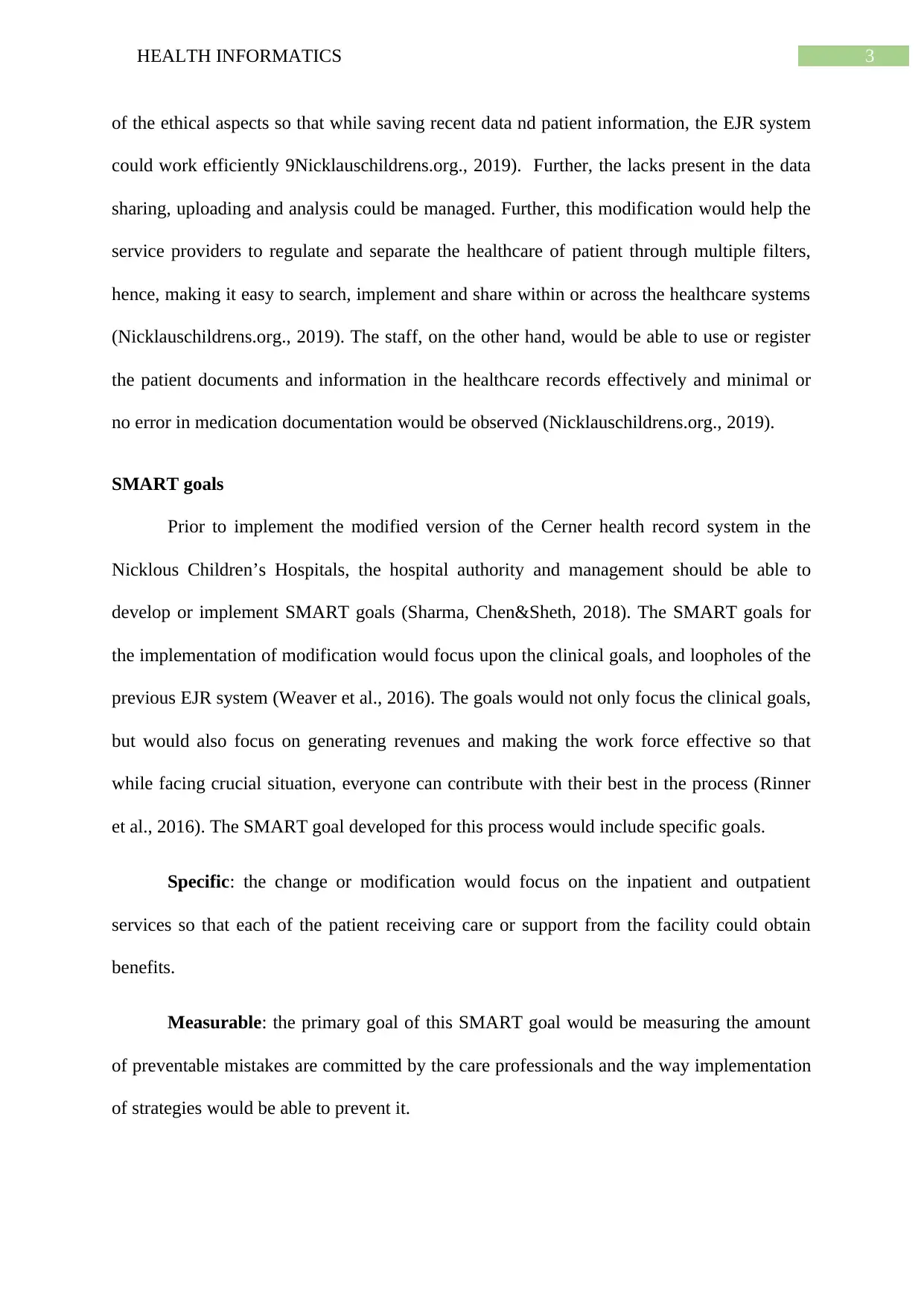
3HEALTH INFORMATICS
of the ethical aspects so that while saving recent data nd patient information, the EJR system
could work efficiently 9Nicklauschildrens.org., 2019). Further, the lacks present in the data
sharing, uploading and analysis could be managed. Further, this modification would help the
service providers to regulate and separate the healthcare of patient through multiple filters,
hence, making it easy to search, implement and share within or across the healthcare systems
(Nicklauschildrens.org., 2019). The staff, on the other hand, would be able to use or register
the patient documents and information in the healthcare records effectively and minimal or
no error in medication documentation would be observed (Nicklauschildrens.org., 2019).
SMART goals
Prior to implement the modified version of the Cerner health record system in the
Nicklous Children’s Hospitals, the hospital authority and management should be able to
develop or implement SMART goals (Sharma, Chen&Sheth, 2018). The SMART goals for
the implementation of modification would focus upon the clinical goals, and loopholes of the
previous EJR system (Weaver et al., 2016). The goals would not only focus the clinical goals,
but would also focus on generating revenues and making the work force effective so that
while facing crucial situation, everyone can contribute with their best in the process (Rinner
et al., 2016). The SMART goal developed for this process would include specific goals.
Specific: the change or modification would focus on the inpatient and outpatient
services so that each of the patient receiving care or support from the facility could obtain
benefits.
Measurable: the primary goal of this SMART goal would be measuring the amount
of preventable mistakes are committed by the care professionals and the way implementation
of strategies would be able to prevent it.
of the ethical aspects so that while saving recent data nd patient information, the EJR system
could work efficiently 9Nicklauschildrens.org., 2019). Further, the lacks present in the data
sharing, uploading and analysis could be managed. Further, this modification would help the
service providers to regulate and separate the healthcare of patient through multiple filters,
hence, making it easy to search, implement and share within or across the healthcare systems
(Nicklauschildrens.org., 2019). The staff, on the other hand, would be able to use or register
the patient documents and information in the healthcare records effectively and minimal or
no error in medication documentation would be observed (Nicklauschildrens.org., 2019).
SMART goals
Prior to implement the modified version of the Cerner health record system in the
Nicklous Children’s Hospitals, the hospital authority and management should be able to
develop or implement SMART goals (Sharma, Chen&Sheth, 2018). The SMART goals for
the implementation of modification would focus upon the clinical goals, and loopholes of the
previous EJR system (Weaver et al., 2016). The goals would not only focus the clinical goals,
but would also focus on generating revenues and making the work force effective so that
while facing crucial situation, everyone can contribute with their best in the process (Rinner
et al., 2016). The SMART goal developed for this process would include specific goals.
Specific: the change or modification would focus on the inpatient and outpatient
services so that each of the patient receiving care or support from the facility could obtain
benefits.
Measurable: the primary goal of this SMART goal would be measuring the amount
of preventable mistakes are committed by the care professionals and the way implementation
of strategies would be able to prevent it.
Paraphrase This Document
Need a fresh take? Get an instant paraphrase of this document with our AI Paraphraser
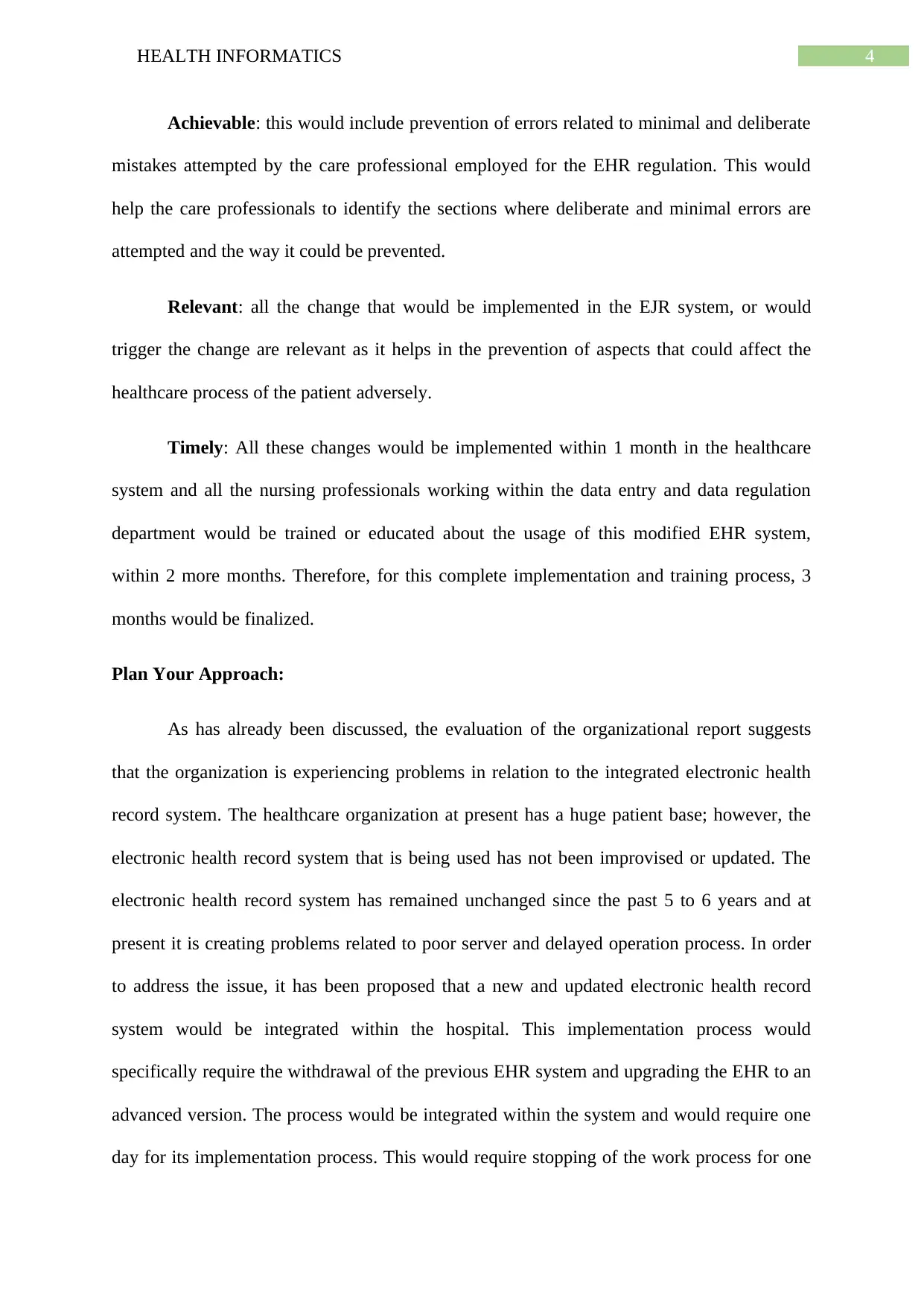
4HEALTH INFORMATICS
Achievable: this would include prevention of errors related to minimal and deliberate
mistakes attempted by the care professional employed for the EHR regulation. This would
help the care professionals to identify the sections where deliberate and minimal errors are
attempted and the way it could be prevented.
Relevant: all the change that would be implemented in the EJR system, or would
trigger the change are relevant as it helps in the prevention of aspects that could affect the
healthcare process of the patient adversely.
Timely: All these changes would be implemented within 1 month in the healthcare
system and all the nursing professionals working within the data entry and data regulation
department would be trained or educated about the usage of this modified EHR system,
within 2 more months. Therefore, for this complete implementation and training process, 3
months would be finalized.
Plan Your Approach:
As has already been discussed, the evaluation of the organizational report suggests
that the organization is experiencing problems in relation to the integrated electronic health
record system. The healthcare organization at present has a huge patient base; however, the
electronic health record system that is being used has not been improvised or updated. The
electronic health record system has remained unchanged since the past 5 to 6 years and at
present it is creating problems related to poor server and delayed operation process. In order
to address the issue, it has been proposed that a new and updated electronic health record
system would be integrated within the hospital. This implementation process would
specifically require the withdrawal of the previous EHR system and upgrading the EHR to an
advanced version. The process would be integrated within the system and would require one
day for its implementation process. This would require stopping of the work process for one
Achievable: this would include prevention of errors related to minimal and deliberate
mistakes attempted by the care professional employed for the EHR regulation. This would
help the care professionals to identify the sections where deliberate and minimal errors are
attempted and the way it could be prevented.
Relevant: all the change that would be implemented in the EJR system, or would
trigger the change are relevant as it helps in the prevention of aspects that could affect the
healthcare process of the patient adversely.
Timely: All these changes would be implemented within 1 month in the healthcare
system and all the nursing professionals working within the data entry and data regulation
department would be trained or educated about the usage of this modified EHR system,
within 2 more months. Therefore, for this complete implementation and training process, 3
months would be finalized.
Plan Your Approach:
As has already been discussed, the evaluation of the organizational report suggests
that the organization is experiencing problems in relation to the integrated electronic health
record system. The healthcare organization at present has a huge patient base; however, the
electronic health record system that is being used has not been improvised or updated. The
electronic health record system has remained unchanged since the past 5 to 6 years and at
present it is creating problems related to poor server and delayed operation process. In order
to address the issue, it has been proposed that a new and updated electronic health record
system would be integrated within the hospital. This implementation process would
specifically require the withdrawal of the previous EHR system and upgrading the EHR to an
advanced version. The process would be integrated within the system and would require one
day for its implementation process. This would require stopping of the work process for one
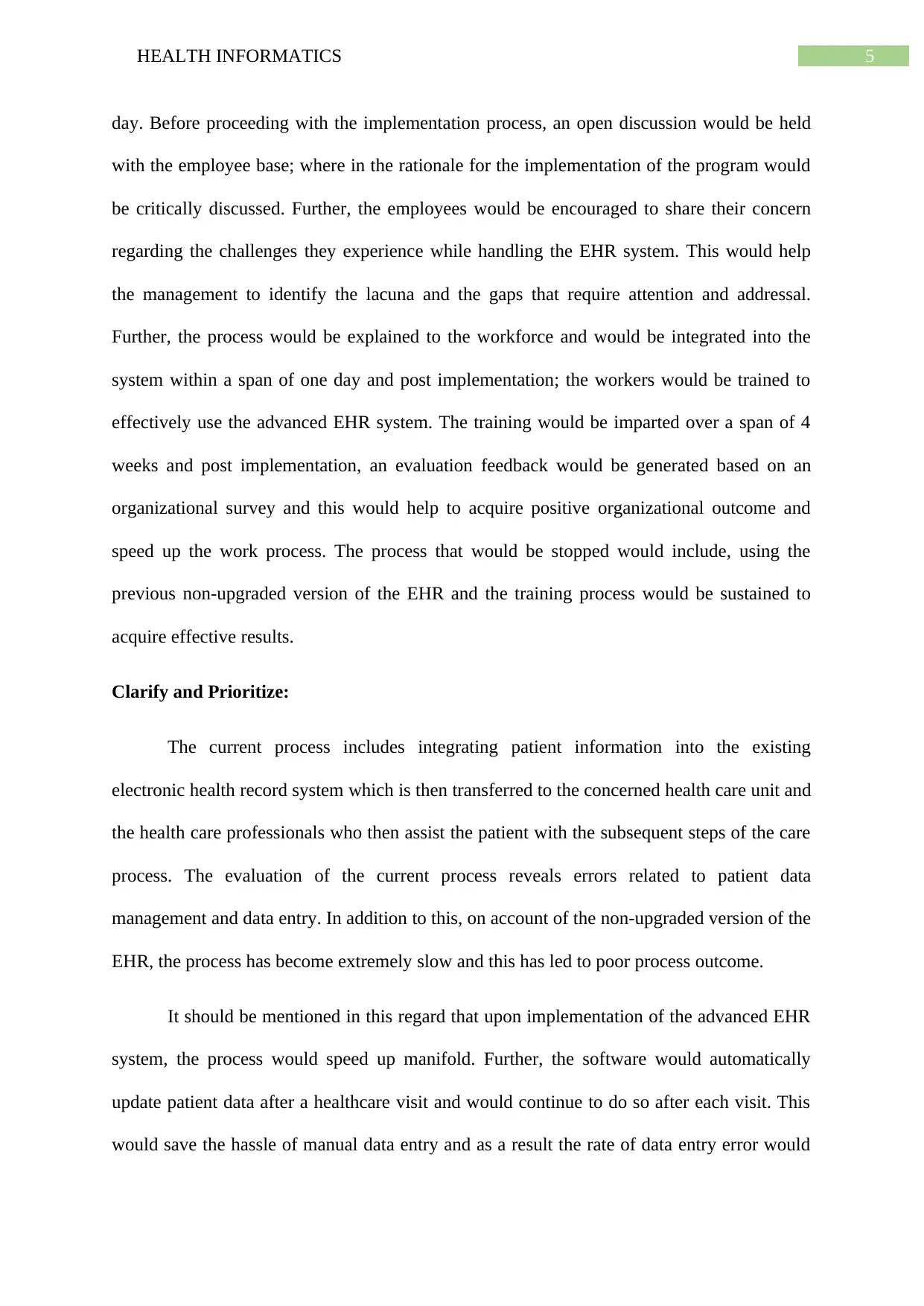
5HEALTH INFORMATICS
day. Before proceeding with the implementation process, an open discussion would be held
with the employee base; where in the rationale for the implementation of the program would
be critically discussed. Further, the employees would be encouraged to share their concern
regarding the challenges they experience while handling the EHR system. This would help
the management to identify the lacuna and the gaps that require attention and addressal.
Further, the process would be explained to the workforce and would be integrated into the
system within a span of one day and post implementation; the workers would be trained to
effectively use the advanced EHR system. The training would be imparted over a span of 4
weeks and post implementation, an evaluation feedback would be generated based on an
organizational survey and this would help to acquire positive organizational outcome and
speed up the work process. The process that would be stopped would include, using the
previous non-upgraded version of the EHR and the training process would be sustained to
acquire effective results.
Clarify and Prioritize:
The current process includes integrating patient information into the existing
electronic health record system which is then transferred to the concerned health care unit and
the health care professionals who then assist the patient with the subsequent steps of the care
process. The evaluation of the current process reveals errors related to patient data
management and data entry. In addition to this, on account of the non-upgraded version of the
EHR, the process has become extremely slow and this has led to poor process outcome.
It should be mentioned in this regard that upon implementation of the advanced EHR
system, the process would speed up manifold. Further, the software would automatically
update patient data after a healthcare visit and would continue to do so after each visit. This
would save the hassle of manual data entry and as a result the rate of data entry error would
day. Before proceeding with the implementation process, an open discussion would be held
with the employee base; where in the rationale for the implementation of the program would
be critically discussed. Further, the employees would be encouraged to share their concern
regarding the challenges they experience while handling the EHR system. This would help
the management to identify the lacuna and the gaps that require attention and addressal.
Further, the process would be explained to the workforce and would be integrated into the
system within a span of one day and post implementation; the workers would be trained to
effectively use the advanced EHR system. The training would be imparted over a span of 4
weeks and post implementation, an evaluation feedback would be generated based on an
organizational survey and this would help to acquire positive organizational outcome and
speed up the work process. The process that would be stopped would include, using the
previous non-upgraded version of the EHR and the training process would be sustained to
acquire effective results.
Clarify and Prioritize:
The current process includes integrating patient information into the existing
electronic health record system which is then transferred to the concerned health care unit and
the health care professionals who then assist the patient with the subsequent steps of the care
process. The evaluation of the current process reveals errors related to patient data
management and data entry. In addition to this, on account of the non-upgraded version of the
EHR, the process has become extremely slow and this has led to poor process outcome.
It should be mentioned in this regard that upon implementation of the advanced EHR
system, the process would speed up manifold. Further, the software would automatically
update patient data after a healthcare visit and would continue to do so after each visit. This
would save the hassle of manual data entry and as a result the rate of data entry error would
⊘ This is a preview!⊘
Do you want full access?
Subscribe today to unlock all pages.

Trusted by 1+ million students worldwide
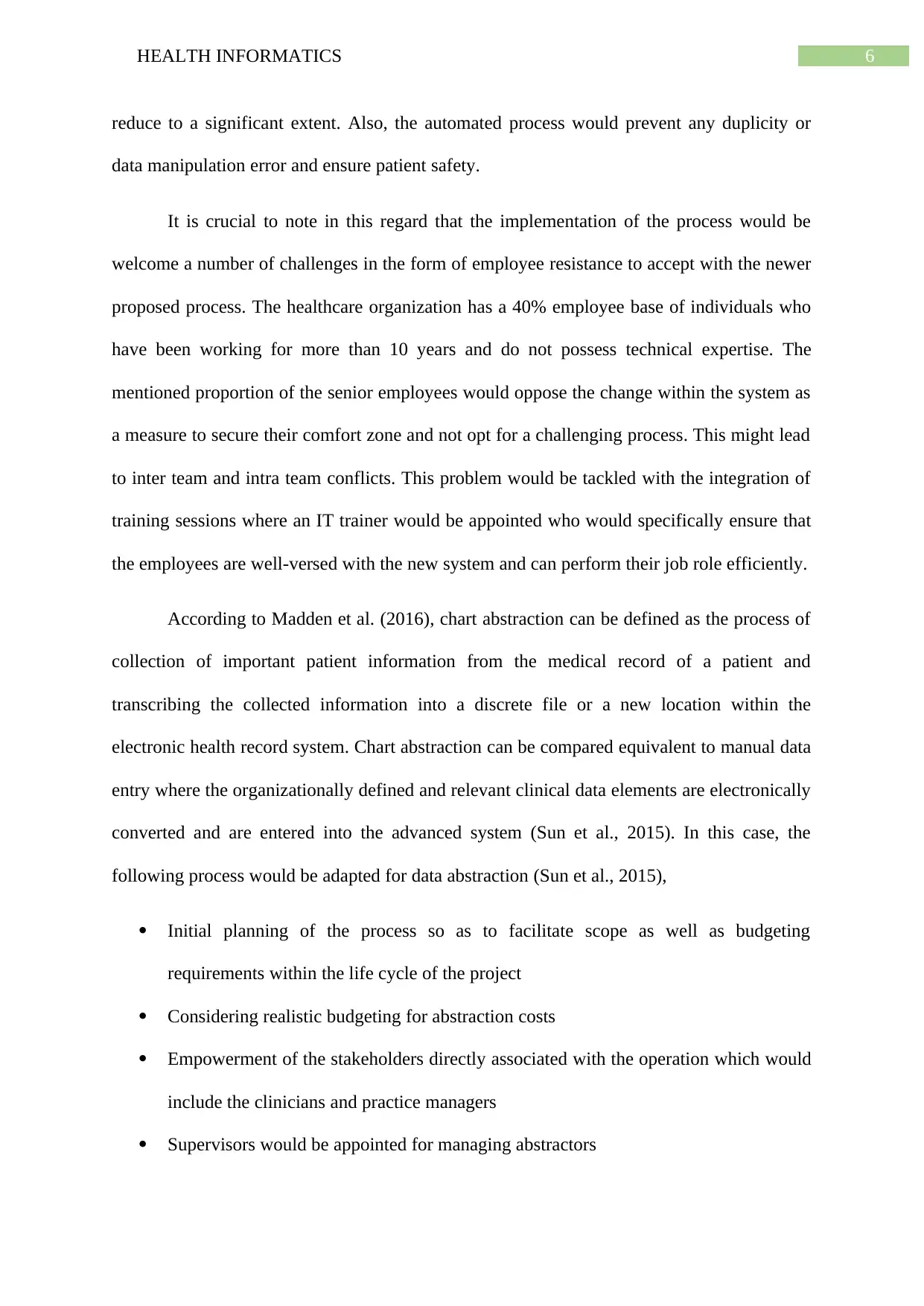
6HEALTH INFORMATICS
reduce to a significant extent. Also, the automated process would prevent any duplicity or
data manipulation error and ensure patient safety.
It is crucial to note in this regard that the implementation of the process would be
welcome a number of challenges in the form of employee resistance to accept with the newer
proposed process. The healthcare organization has a 40% employee base of individuals who
have been working for more than 10 years and do not possess technical expertise. The
mentioned proportion of the senior employees would oppose the change within the system as
a measure to secure their comfort zone and not opt for a challenging process. This might lead
to inter team and intra team conflicts. This problem would be tackled with the integration of
training sessions where an IT trainer would be appointed who would specifically ensure that
the employees are well-versed with the new system and can perform their job role efficiently.
According to Madden et al. (2016), chart abstraction can be defined as the process of
collection of important patient information from the medical record of a patient and
transcribing the collected information into a discrete file or a new location within the
electronic health record system. Chart abstraction can be compared equivalent to manual data
entry where the organizationally defined and relevant clinical data elements are electronically
converted and are entered into the advanced system (Sun et al., 2015). In this case, the
following process would be adapted for data abstraction (Sun et al., 2015),
Initial planning of the process so as to facilitate scope as well as budgeting
requirements within the life cycle of the project
Considering realistic budgeting for abstraction costs
Empowerment of the stakeholders directly associated with the operation which would
include the clinicians and practice managers
Supervisors would be appointed for managing abstractors
reduce to a significant extent. Also, the automated process would prevent any duplicity or
data manipulation error and ensure patient safety.
It is crucial to note in this regard that the implementation of the process would be
welcome a number of challenges in the form of employee resistance to accept with the newer
proposed process. The healthcare organization has a 40% employee base of individuals who
have been working for more than 10 years and do not possess technical expertise. The
mentioned proportion of the senior employees would oppose the change within the system as
a measure to secure their comfort zone and not opt for a challenging process. This might lead
to inter team and intra team conflicts. This problem would be tackled with the integration of
training sessions where an IT trainer would be appointed who would specifically ensure that
the employees are well-versed with the new system and can perform their job role efficiently.
According to Madden et al. (2016), chart abstraction can be defined as the process of
collection of important patient information from the medical record of a patient and
transcribing the collected information into a discrete file or a new location within the
electronic health record system. Chart abstraction can be compared equivalent to manual data
entry where the organizationally defined and relevant clinical data elements are electronically
converted and are entered into the advanced system (Sun et al., 2015). In this case, the
following process would be adapted for data abstraction (Sun et al., 2015),
Initial planning of the process so as to facilitate scope as well as budgeting
requirements within the life cycle of the project
Considering realistic budgeting for abstraction costs
Empowerment of the stakeholders directly associated with the operation which would
include the clinicians and practice managers
Supervisors would be appointed for managing abstractors
Paraphrase This Document
Need a fresh take? Get an instant paraphrase of this document with our AI Paraphraser
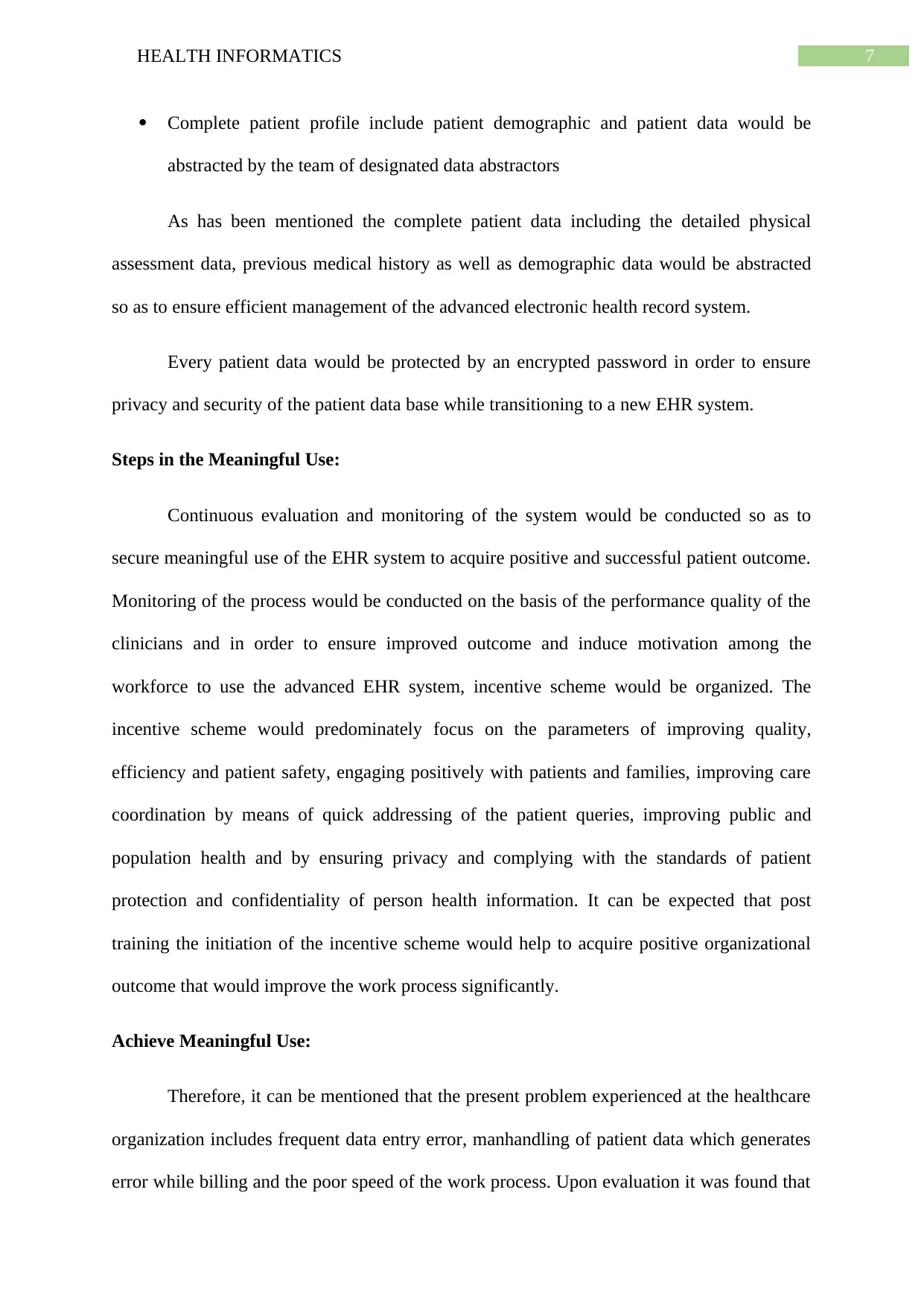
7HEALTH INFORMATICS
Complete patient profile include patient demographic and patient data would be
abstracted by the team of designated data abstractors
As has been mentioned the complete patient data including the detailed physical
assessment data, previous medical history as well as demographic data would be abstracted
so as to ensure efficient management of the advanced electronic health record system.
Every patient data would be protected by an encrypted password in order to ensure
privacy and security of the patient data base while transitioning to a new EHR system.
Steps in the Meaningful Use:
Continuous evaluation and monitoring of the system would be conducted so as to
secure meaningful use of the EHR system to acquire positive and successful patient outcome.
Monitoring of the process would be conducted on the basis of the performance quality of the
clinicians and in order to ensure improved outcome and induce motivation among the
workforce to use the advanced EHR system, incentive scheme would be organized. The
incentive scheme would predominately focus on the parameters of improving quality,
efficiency and patient safety, engaging positively with patients and families, improving care
coordination by means of quick addressing of the patient queries, improving public and
population health and by ensuring privacy and complying with the standards of patient
protection and confidentiality of person health information. It can be expected that post
training the initiation of the incentive scheme would help to acquire positive organizational
outcome that would improve the work process significantly.
Achieve Meaningful Use:
Therefore, it can be mentioned that the present problem experienced at the healthcare
organization includes frequent data entry error, manhandling of patient data which generates
error while billing and the poor speed of the work process. Upon evaluation it was found that
Complete patient profile include patient demographic and patient data would be
abstracted by the team of designated data abstractors
As has been mentioned the complete patient data including the detailed physical
assessment data, previous medical history as well as demographic data would be abstracted
so as to ensure efficient management of the advanced electronic health record system.
Every patient data would be protected by an encrypted password in order to ensure
privacy and security of the patient data base while transitioning to a new EHR system.
Steps in the Meaningful Use:
Continuous evaluation and monitoring of the system would be conducted so as to
secure meaningful use of the EHR system to acquire positive and successful patient outcome.
Monitoring of the process would be conducted on the basis of the performance quality of the
clinicians and in order to ensure improved outcome and induce motivation among the
workforce to use the advanced EHR system, incentive scheme would be organized. The
incentive scheme would predominately focus on the parameters of improving quality,
efficiency and patient safety, engaging positively with patients and families, improving care
coordination by means of quick addressing of the patient queries, improving public and
population health and by ensuring privacy and complying with the standards of patient
protection and confidentiality of person health information. It can be expected that post
training the initiation of the incentive scheme would help to acquire positive organizational
outcome that would improve the work process significantly.
Achieve Meaningful Use:
Therefore, it can be mentioned that the present problem experienced at the healthcare
organization includes frequent data entry error, manhandling of patient data which generates
error while billing and the poor speed of the work process. Upon evaluation it was found that
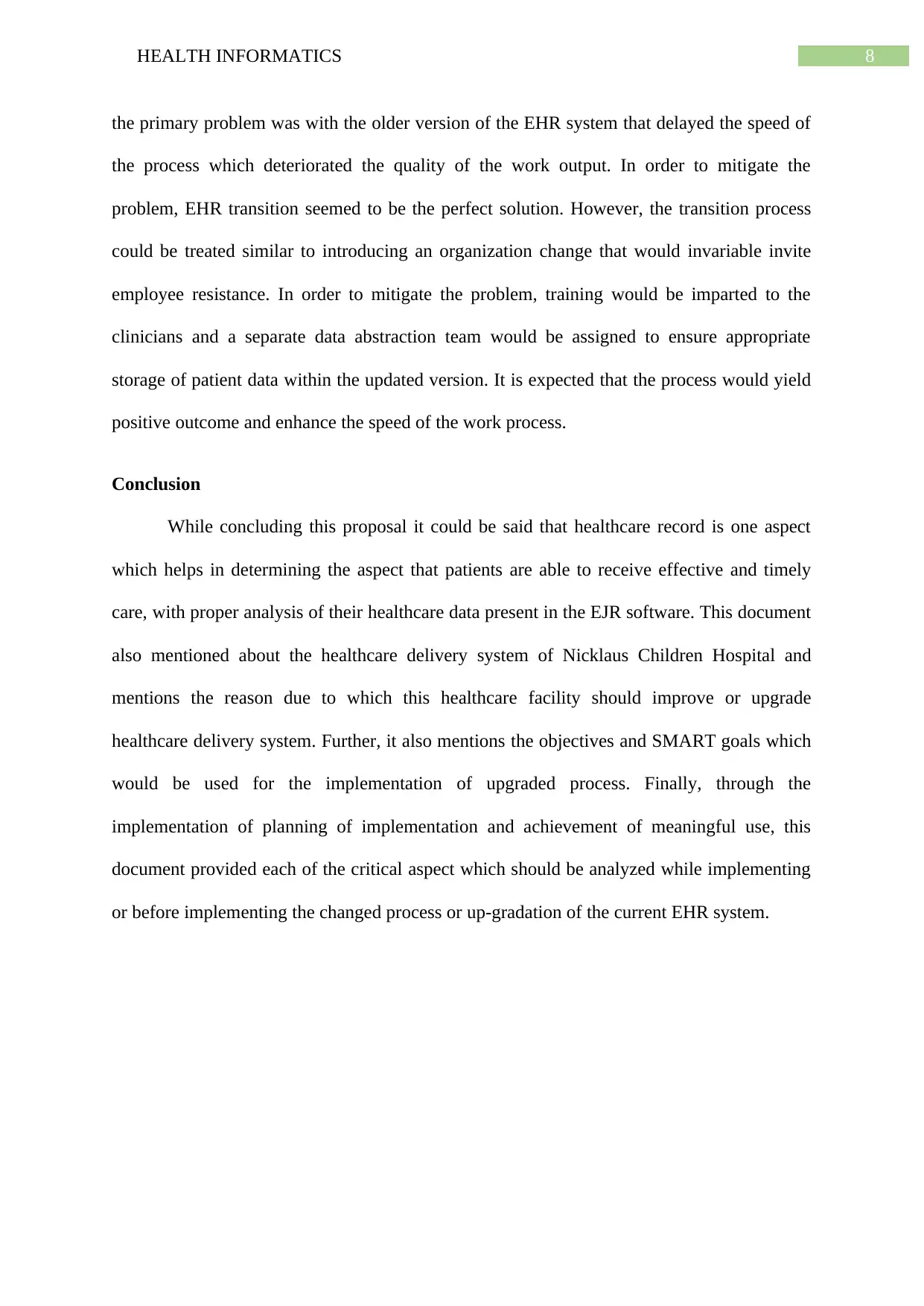
8HEALTH INFORMATICS
the primary problem was with the older version of the EHR system that delayed the speed of
the process which deteriorated the quality of the work output. In order to mitigate the
problem, EHR transition seemed to be the perfect solution. However, the transition process
could be treated similar to introducing an organization change that would invariable invite
employee resistance. In order to mitigate the problem, training would be imparted to the
clinicians and a separate data abstraction team would be assigned to ensure appropriate
storage of patient data within the updated version. It is expected that the process would yield
positive outcome and enhance the speed of the work process.
Conclusion
While concluding this proposal it could be said that healthcare record is one aspect
which helps in determining the aspect that patients are able to receive effective and timely
care, with proper analysis of their healthcare data present in the EJR software. This document
also mentioned about the healthcare delivery system of Nicklaus Children Hospital and
mentions the reason due to which this healthcare facility should improve or upgrade
healthcare delivery system. Further, it also mentions the objectives and SMART goals which
would be used for the implementation of upgraded process. Finally, through the
implementation of planning of implementation and achievement of meaningful use, this
document provided each of the critical aspect which should be analyzed while implementing
or before implementing the changed process or up-gradation of the current EHR system.
the primary problem was with the older version of the EHR system that delayed the speed of
the process which deteriorated the quality of the work output. In order to mitigate the
problem, EHR transition seemed to be the perfect solution. However, the transition process
could be treated similar to introducing an organization change that would invariable invite
employee resistance. In order to mitigate the problem, training would be imparted to the
clinicians and a separate data abstraction team would be assigned to ensure appropriate
storage of patient data within the updated version. It is expected that the process would yield
positive outcome and enhance the speed of the work process.
Conclusion
While concluding this proposal it could be said that healthcare record is one aspect
which helps in determining the aspect that patients are able to receive effective and timely
care, with proper analysis of their healthcare data present in the EJR software. This document
also mentioned about the healthcare delivery system of Nicklaus Children Hospital and
mentions the reason due to which this healthcare facility should improve or upgrade
healthcare delivery system. Further, it also mentions the objectives and SMART goals which
would be used for the implementation of upgraded process. Finally, through the
implementation of planning of implementation and achievement of meaningful use, this
document provided each of the critical aspect which should be analyzed while implementing
or before implementing the changed process or up-gradation of the current EHR system.
⊘ This is a preview!⊘
Do you want full access?
Subscribe today to unlock all pages.

Trusted by 1+ million students worldwide
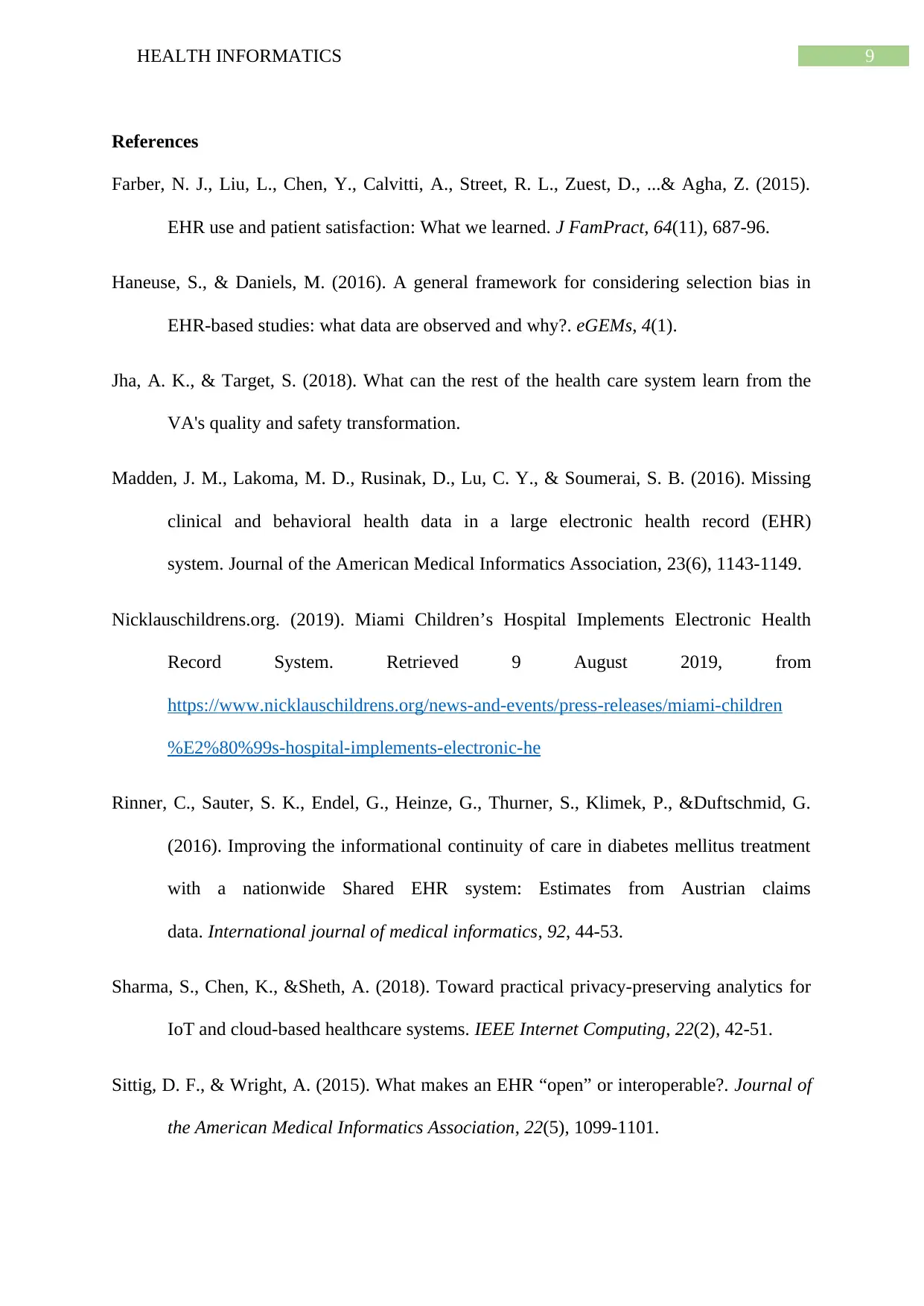
9HEALTH INFORMATICS
References
Farber, N. J., Liu, L., Chen, Y., Calvitti, A., Street, R. L., Zuest, D., ...& Agha, Z. (2015).
EHR use and patient satisfaction: What we learned. J FamPract, 64(11), 687-96.
Haneuse, S., & Daniels, M. (2016). A general framework for considering selection bias in
EHR-based studies: what data are observed and why?. eGEMs, 4(1).
Jha, A. K., & Target, S. (2018). What can the rest of the health care system learn from the
VA's quality and safety transformation.
Madden, J. M., Lakoma, M. D., Rusinak, D., Lu, C. Y., & Soumerai, S. B. (2016). Missing
clinical and behavioral health data in a large electronic health record (EHR)
system. Journal of the American Medical Informatics Association, 23(6), 1143-1149.
Nicklauschildrens.org. (2019). Miami Children’s Hospital Implements Electronic Health
Record System. Retrieved 9 August 2019, from
https://www.nicklauschildrens.org/news-and-events/press-releases/miami-children
%E2%80%99s-hospital-implements-electronic-he
Rinner, C., Sauter, S. K., Endel, G., Heinze, G., Thurner, S., Klimek, P., &Duftschmid, G.
(2016). Improving the informational continuity of care in diabetes mellitus treatment
with a nationwide Shared EHR system: Estimates from Austrian claims
data. International journal of medical informatics, 92, 44-53.
Sharma, S., Chen, K., &Sheth, A. (2018). Toward practical privacy-preserving analytics for
IoT and cloud-based healthcare systems. IEEE Internet Computing, 22(2), 42-51.
Sittig, D. F., & Wright, A. (2015). What makes an EHR “open” or interoperable?. Journal of
the American Medical Informatics Association, 22(5), 1099-1101.
References
Farber, N. J., Liu, L., Chen, Y., Calvitti, A., Street, R. L., Zuest, D., ...& Agha, Z. (2015).
EHR use and patient satisfaction: What we learned. J FamPract, 64(11), 687-96.
Haneuse, S., & Daniels, M. (2016). A general framework for considering selection bias in
EHR-based studies: what data are observed and why?. eGEMs, 4(1).
Jha, A. K., & Target, S. (2018). What can the rest of the health care system learn from the
VA's quality and safety transformation.
Madden, J. M., Lakoma, M. D., Rusinak, D., Lu, C. Y., & Soumerai, S. B. (2016). Missing
clinical and behavioral health data in a large electronic health record (EHR)
system. Journal of the American Medical Informatics Association, 23(6), 1143-1149.
Nicklauschildrens.org. (2019). Miami Children’s Hospital Implements Electronic Health
Record System. Retrieved 9 August 2019, from
https://www.nicklauschildrens.org/news-and-events/press-releases/miami-children
%E2%80%99s-hospital-implements-electronic-he
Rinner, C., Sauter, S. K., Endel, G., Heinze, G., Thurner, S., Klimek, P., &Duftschmid, G.
(2016). Improving the informational continuity of care in diabetes mellitus treatment
with a nationwide Shared EHR system: Estimates from Austrian claims
data. International journal of medical informatics, 92, 44-53.
Sharma, S., Chen, K., &Sheth, A. (2018). Toward practical privacy-preserving analytics for
IoT and cloud-based healthcare systems. IEEE Internet Computing, 22(2), 42-51.
Sittig, D. F., & Wright, A. (2015). What makes an EHR “open” or interoperable?. Journal of
the American Medical Informatics Association, 22(5), 1099-1101.
Paraphrase This Document
Need a fresh take? Get an instant paraphrase of this document with our AI Paraphraser
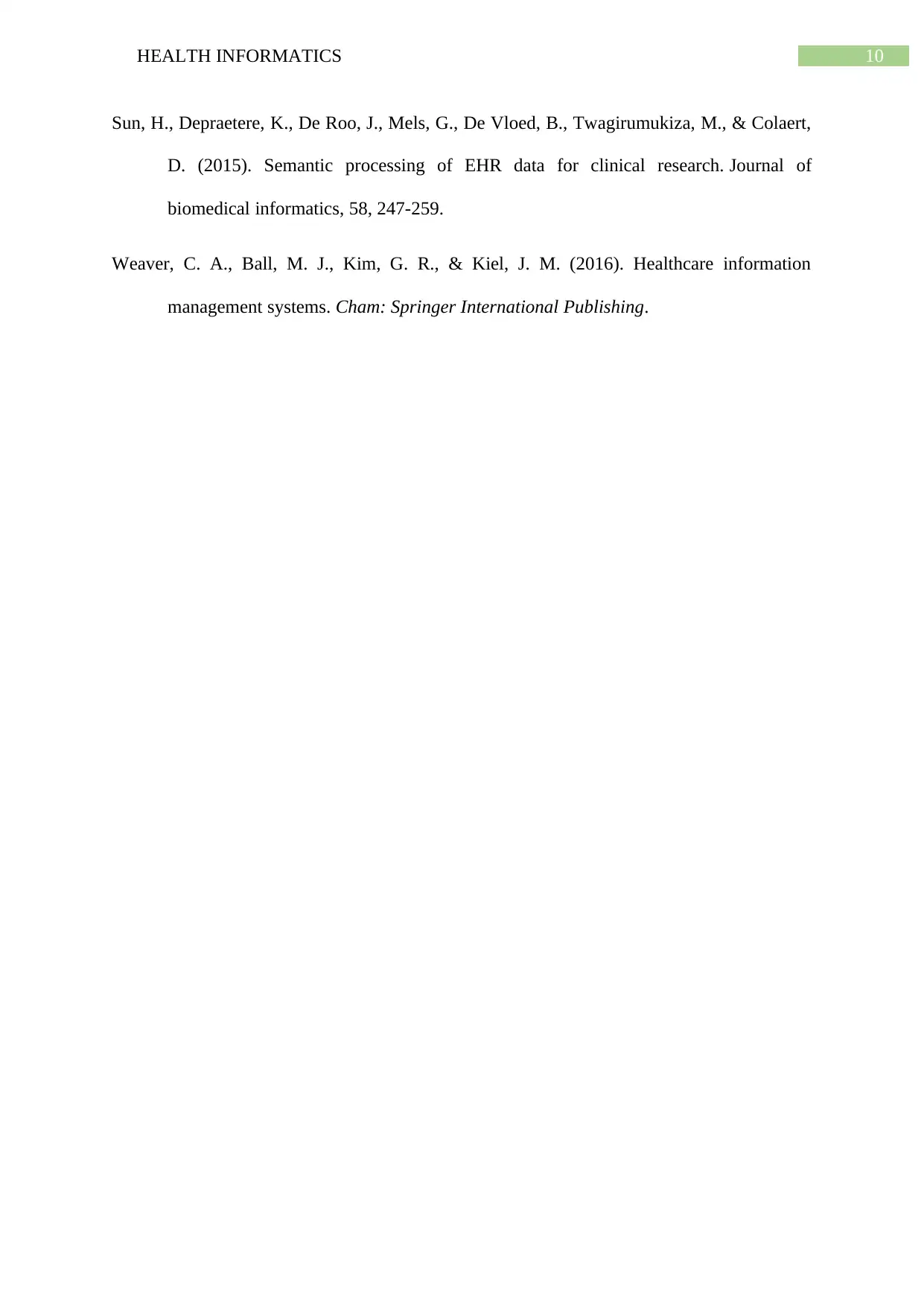
10HEALTH INFORMATICS
Sun, H., Depraetere, K., De Roo, J., Mels, G., De Vloed, B., Twagirumukiza, M., & Colaert,
D. (2015). Semantic processing of EHR data for clinical research. Journal of
biomedical informatics, 58, 247-259.
Weaver, C. A., Ball, M. J., Kim, G. R., & Kiel, J. M. (2016). Healthcare information
management systems. Cham: Springer International Publishing.
Sun, H., Depraetere, K., De Roo, J., Mels, G., De Vloed, B., Twagirumukiza, M., & Colaert,
D. (2015). Semantic processing of EHR data for clinical research. Journal of
biomedical informatics, 58, 247-259.
Weaver, C. A., Ball, M. J., Kim, G. R., & Kiel, J. M. (2016). Healthcare information
management systems. Cham: Springer International Publishing.
1 out of 11
Related Documents
Your All-in-One AI-Powered Toolkit for Academic Success.
+13062052269
info@desklib.com
Available 24*7 on WhatsApp / Email
![[object Object]](/_next/static/media/star-bottom.7253800d.svg)
Unlock your academic potential
Copyright © 2020–2025 A2Z Services. All Rights Reserved. Developed and managed by ZUCOL.





